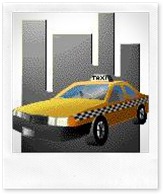Entries Tagged 'freelance copywriter' ↓
February 22nd, 2010 — copywriter, copywriting tips, freelance copywriter, website copywriting

Those immortal words were famously uttered by Travis Bickle (Robert De Niro) in the 1976 classic, “Taxi Driver”.
This post isn’t about that particular iconic film though. Rather, I want to talk about your website copywriting and how it should be written to gain the greatest effect.
Who do you want to read your website?
This is a topic that I have touched on in the past but it is so important, I’m going to talk about it again.
You might think it an odd question – “who do you want to read your website?” – but it isn’t really.
Look at it another way – what do you want your website to do?
Hopefully you answered “sell” or perhaps “generate enquiries”. But you will only do that if your website copy talks to your reader. Think back to the last networking event you went to. No doubt someone came up and introduced themselves to you and launched into their elevator pitch. What would you find most interesting? Someone who says:
“I’m John, I sell websites. My websites have state of the art features and they look great. They are really eye catching and I work with clients all over the country. I can create ecommerce sites, flash sites and just about anything else you can think of. My company is called Websitearama, this is my card, look me up.”
Lost the will to live yet? I’m guessing that you have now made your excuses and left John to find another victim to bore.
But what if John had said this?
“Hi, I’m John and I can help your website attract targeted traffic that will generate a constant stream of sales. With our software you’ll never lose a sale because it will automatically follow up every lead. You will no longer be walking away from business because you don’t have time to keep in touch with all your prospects – your website software will do it for you.”
In the first scenario John bangs on about his company. At no point does he even attempt to say how he can help his clients. His websites have state of the art features – so what? The are really eye-catching – so what?
But the second attempt starts to address his audience. His website attracts targeted traffic – so what? – so it generates a constant stream of leads. It follows up every lead automatically – so what? – so you’ll never lose another sale.
This time John has qualified the benefits of his product by illustrating what that will mean to his clients.
So what’s all that got to do with websites?
When someone lands on your website they are there for a reason – they want to buy what you are selling.
To make yourself stand out from all the other websites, you have to make sure you give them what they want. If they land on your site only to read all about your company (an Ego website) they’ll get bored and move on.
But if your website copy addresses them directly and tells them what you will do for them, you’ll get their attention.
You
That is a word that should be littered throughout your web copy. By using “you” and “your” you are directly addressing your reader. You are involving them in your website and showing them precisely why they’ll benefit from your product/service.
Stating what your benefits are and what they’ll do for your reader will prevent them from saying those dreaded words:
“What’s in it for me?”
If they have to say that you’ve failed to get your message across clearly.
So next time you are writing your web copy make sure you banish “we” and replace it with “you”. By writing directly to your reader you’ll begin to write benefits driven copy that will sell. It may take a bit of practice but stick with it as it will pay off.
By the way, this is also true for your other sales materials.
Sally Ormond – freelance copywriter
February 17th, 2010 — copywriter, copywriting tips, freelance copywriter, website copywriter

Before you run away screaming – this isn’t going to be a post that bangs on about how your business is in dire need of a freelance copywriter – oh, and I just happen to know one – me!
This is all about keeping your copywriting benefits driven.
Identify your benefits
You’re probably sat there now saying…
“What’s she on about, of course I know what the benefits of my product are.”
Are you sure about that?

Let’s take George here as an example. He runs a small business that sells recycled paper goods – things like gift bags, wrapping paper, envelopes etc.
All over his website he mentions that all his products are made from recycled paper and, of course, are also recyclable themselves.
Whoop-di-do, so what?
The fact that his products are made from recycled paper (and are recyclable) isn’t a benefit. It is a feature.
This is a mistake that is made on numerous websites.
If George came up to me and launched into his pitch this is probably how the conversation would go:
George: “You should buy my product because it’s made from recyclable materials”
Me: “So what?”
But, if he changed his approach and concentrated on the benefit, it would go something like…
George: “By buying my recycled product you will also have peace of mind that you are helping the environment and therefore helping us all to work towards a better world”
Me: “Wow, you’re right. I hadn’t thought of it like that.”
(a bit cheesy but you get my drift)
By immediately stating a benefit – i.e. what his product will do for me – he has shown that he understands my needs and has fulfilled them.
Your benefit could be like Georges’, or it could save your customer money, give them kudos, include them in a select community etc. What it comes down to is what your product will do for them – how it will change their lives for the better.
Get your benefits in fast
Once you’ve identified your benefits you have to get them in your web copy.
The most important information must go first so get your benefits in early. Within the first paragraph if you can.
It is the benefit that your reader is going to be looking for but they don’t want to have to work it out for themselves.
Spell it out to them so they trip over it. If you can identify more than one, put them in a bulleted list to draw attention to them.
Don’t be a wall flower – your benefits are what will sell your product so shout about them for all you’re worth.
February 15th, 2010 — copywriter, copywriting tips, freelance copywriter, search engine optimisation, SEO copywriter

Search engine optimisation – everyone knows the phrase, most people know what it is, some people think they know how to do it.
But only a few can do SEO.
By ‘do SEO’ I mean perform the miracle that is SEO copywriting. It is probably one of the hardest disciplines to master as you are effectively writing for two different audiences at the same time.

In the green corner we have your customers – real life, living and breathing people who you’ve got to convince if you want them to buy your product.
And in the red corner, the search engines – mystical algorithms you have to convince that your website is relevant to the search terms your customers are using.
What SEO is really all about?
In a previous post I looked at what SEO is really all about and that why keyword density is a thing of the past.
We’ve all seen dreadful copy on websites that is stuffed with keywords. The result is something that looks nasty, reads terribly and that won’t sell anything.
There are some people out there who maintain you can’t have well written, readable SEO copy.
Why not?
Copy that is written naturally and that engages with your customers is going to contain your keywords. But not so many that it renders the whole website unreadable. They will be present in sufficient numbers to help your organic rankings and provide relevant, interesting copy for your readers.
The truth is that SEO and great copy go hand in hand – don’t let anyone else try to tell you otherwise.
I stumbled upon this video which makes this point perfectly. It was put together by Ian Lurie of Conversation Marketing. It’s well worth watching so sit back, grab a cuppa and be enlightened.
February 12th, 2010 — copywriter, copywriting tips, freelance copywriter, SEO copywriter
Another important aspect of SEO copywriting is creating a relevant and compelling META description.
Your META description is the text that appears in the search engine results under the page title as shown here:

If you don’t have one in the coding of your website, Google will take a snippet from your page copy. The problem with that is that it may not be relevant and probably won’t convey the message you want to get across to your reader.
Your META description is what will differentiate you from your competitors. It is an opportunity to stand out from the crowd and attract the ‘click’ to your site.
To help you make the most of your META description, I’ve put together a list of 10 ways to create a great one:
- Unique – remember Google lists pages not websites so make sure each page of your website has a unique META description.
- Complement the page title – whatever you write for your page title, your META description should complement it. After all, if your page title tells your reader one thing and the description another, they won’t click on your link.
- Complete sentences – it is important that your description is meaningful so make sure you use full sentences.
- Stand out – this is your chance to make your site stand out from your competitors. Don’t just follow what everyone has written, make your mark.
- Product names – if you have product name that is well known get it in your description. Show people exactly what you sell.
- Offers – if you have an offer such as free p+p, make sure it goes into your description.
- 160 characters – Google only shows approximately 160 characters in the META description so make sure you stick to the limit. You can use the run off to your advantage though if you can engineer your description so the … appear at a point that will make your reader click the link to read more.
- Factual – make sure what you tell people in your description comes across as factual as this carries weight.
- CTA – if you can, get a call to action into your description to get your reader to take immediate action by clicking on your link.
- Don’t copy your page title – try to use different a different word order to that in your page title. By all means use your keywords but add modifiers so your reader isn’t reading the same information twice.
If you are unsure how to use the META description, a good SEO copywriter will be able to help you.
Remember this may be the first contact you’ll have with a reader. It may only be 160 characters long, but everyone is important and should be made to count.











